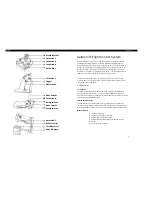
Sundaya Apple Regulator
Quick Start Manual
The Apple charge controller is ideal for people living in remote locations where battery protection from excessive discharges is of
paramount importance and the cost of battery replacement is very high. To achieve this level of battery protection the loads are
connected directly to the Apple charge controller to allow it to turn off your loads when the battery voltage becomes critically low,
thus protecting the battery from excessive discharge. You may choose not to use this feature and connect your loads through
appropriate fuses or circuit breakers to your battery and not use the Apple load connection. This may be the case if:
•
you aren’t concerned about your battery replacement cost
•
your loads exceed the 5, 10 or 20 amp rating of the apple
load controller; and/or
•
you have a back-up generator
Main Features:
•
8mm input and output connectors with clear polarity
markings
•
Extremely low voltage drop over power Mosfets for high
efficiency
•
Boost Charge mode
•
Electronic Overload/Short circuit protection with LED
Indicator
•
Electronic Master-switch to centrally cut off all loads
•
LED voltage indicators for charging and low voltage
disconnect
•
Low voltage alarm
•
PWM charging with temperature compensation
LED Indicators and Button/Switch Description:
•
8-steps Battery Voltage LED: The Battery Voltage level is proportional to the number of the LEDs lit up. State of charge can
roughly be equated to voltage when the batteries are at rest (no current flow in or out). All 8 LEDs lit up indicate the batteries are
fully charged (Voltage = 12.7 –13.1 V); Only the first (lowest) LEDs lit up indicate the batteries are almost totally discharged and
that the output of the controller will soon be cut if the LOAD continues to be connected without sufficient charging to replenish the
batteries (Voltage = 11.4 – 11.7V).
•
Deep discharge Cut-Off LED: Indicates that the controller disconnected the load output due to battery voltage falling below 11.6
V ± 0.10 V on Penalty mode 11.5V ± 0.10 V on Non Penalty mode.
•
Display Button: The LEDs will display the status only when the Display Button is pressed.
•
On/Off Master Switch: Toggle the controller output from on to off, or off to on by pressing the switch once.
•
Master-switch / Overload/Short circuit LED: This LED will light up when the User turns off the output by pressing the On/Off
Master-Switch once, or the controller cuts off the output due to a short circuit detected.
•
Charging LED: This LED will light up when charging is taking place.
Installation procedure:
a) Connect the controller to the fully charged battery. (Caution:- please make sure the polarity is correct)
b) Press on the Display Button. All 8 Battery Voltage LEDs should light up if the battery is fully charged.
c) Connect the controller output to the load. Ideally, use low power load first such as a DC lighting product (Ulite3), to verify proper
operation. (Caution:- please make sure the polarity is correct, that positive and negative connections are correctly done).
d) Press the On/Off Master-Switch, and hold for one or two seconds, then release. The Load will turn on.
e) Connect the Solar Panel Input to either 12Vdc Solar modules or 12Vdc charger such as DC10. (Caution:- please make sure the
positive and negative polarity is correctly connected)
f) The Charging LED should light up if charging is taking place.
g) Mount the controller in indoor environment with minimum exposure to rain, moisture or high temperatures such as near the sink
or the stove.
h) The surface to mount the controller on should be of good insulated material such as brick, plastic, or wood.
i) When the Controller is first connected to a half charged battery (Voltage < 12.7V), then the load terminal may be disconnected
until the voltage rises above 12.7 volts and the on/off button is pushed. From then on the load terminal will switch off below 11.6
volts.
Safety:
Short circuit of batteries could generate excessive heat and possibly melt down the cables, causing injury to the User. At least one
(either the positive or the negative) battery lead should be protected by an appropriate HRC fuse. For the leads supplied with the
5A model we recommend using a fuse rated at 20 amps or less. For the 20A model we suggest you use at least 7.9 mm² battery
leads protected by an HRC fuse rated at 45 amps or less. During installation or battery replacement it is advisable to connect and
secure the battery cable to the controller first, before connecting to the terminals on the battery.
Содержание Apple
Страница 7: ...4 ...


























